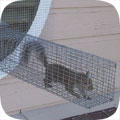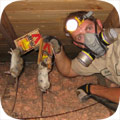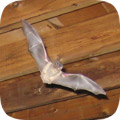- hillcrest@wildlifeanimalcontrol.com
Call 24/7 for a free quote:
858-799-0409
Hillcrest Wildlife Animal Control
Professional Wildlife Removal Company Servicing Hillcrest, CA
If you have a problem with wildlife in your Hillcrest home, your best option is to hire a company that specializes in California wildlife removal only. This is a specialty business, and regular pest control companies do not use the proper techniques to solve animal problems. I have spent many years reviewing California and Hillcrest, and I recommend the following:
Laws of Nature
Cell Phone: 858-799-0409
NOTE: If you have a dog or cat problem, call San Diego County Animal Services: (858) 694-3900

Laws of Nature specializes primarily in removing animals from attics of homes and buildings - this includes squirrels in attics, raccoons, and rats or mice in homes. California also has a documented problem with
bats in buildings, and Laws of Nature is specially trained in bat removal. They also perform general wildlife trapping services, such as the capture and removal of skunks or opossums on the
property. Call 858-799-0409 to discuss your critter problem and schedule a same-day or next-day appointment. Click here to learn more about
what prices we charge in 2024.
When hiring a company to solve your wild animal problem, you want these features:
- Specializes in wildlife removal, not pest control
- Fully California and San Diego County licensed and insured
- Works 7 days per week (critters don't take weekends off)
- Performs full building inspections: enters and inspects attic
- Performs exclusion repairs, with guarantee against animal re-entry
- Offers cleanup of biohazardous wildlife waste
Laws of Nature is a full-service Hillcrest wildlife removal company. This is very different from a regular Hillcrest pest control company. The pest control companies spray poison to kill insects. This is not at all
similar to wildlife removal. Laws of Nature performs a full inspection of the home or property, and determines why the animal(s) are there, and if inside a building, how the animals got inside. All
animals (including rodents) are trapped and removed, or if possible, removed from the building using special exclusion devices. Once the animals are gone, preventative repairs are essential, and
cleanup is sometimes recommended.
 Hillcrest wildlife trapping - it's not as simple as it may seem. It's illegal in California to trap without a license. Trap type is very important and there are many different types, bait is somewhat relevant, trap placement
is vital, and there are dozens of small things that are very important to know.
Safety is a concern. Then once the animal is trapped, it must be removed and dealt with in the proper manner according to California law. We offer Hillcrest raccoon removal. Read more about how to get rid of raccoons.
Hillcrest wildlife trapping - it's not as simple as it may seem. It's illegal in California to trap without a license. Trap type is very important and there are many different types, bait is somewhat relevant, trap placement
is vital, and there are dozens of small things that are very important to know.
Safety is a concern. Then once the animal is trapped, it must be removed and dealt with in the proper manner according to California law. We offer Hillcrest raccoon removal. Read more about how to get rid of raccoons.
 Animals in attics - this is our specialty at Laws of Nature. Many types of animals like to live in attics. This includes squirrels, raccoons, rats, mice, bats, birds, and even possums. Critters like to go into attics for a safe place to live
and raise their young. Removing animals from attics is very complex work, partly because of the presence of baby animals. If you need Hillcrest squirrel removal, we can remove all the squirrels from your attic, and seal out any future ones. Read more about how to get rid of squirrels.
Animals in attics - this is our specialty at Laws of Nature. Many types of animals like to live in attics. This includes squirrels, raccoons, rats, mice, bats, birds, and even possums. Critters like to go into attics for a safe place to live
and raise their young. Removing animals from attics is very complex work, partly because of the presence of baby animals. If you need Hillcrest squirrel removal, we can remove all the squirrels from your attic, and seal out any future ones. Read more about how to get rid of squirrels.
 Rodent control must be done in a very specific way. First off, the most important thing is that all the openings that rats and mice can use to enter a house be sealed. Then all the rodents must be physically trapped and removed.
Never, ever use poison! Most Hillcrest exterminators will just use this lazy poison technique to kill rodents, and it causes more harm than good - dead stinky rats, and it doesn't solve the problem. Call us for correct Hillcrest rat removal. Read more about how to get rid of rats.
Rodent control must be done in a very specific way. First off, the most important thing is that all the openings that rats and mice can use to enter a house be sealed. Then all the rodents must be physically trapped and removed.
Never, ever use poison! Most Hillcrest exterminators will just use this lazy poison technique to kill rodents, and it causes more harm than good - dead stinky rats, and it doesn't solve the problem. Call us for correct Hillcrest rat removal. Read more about how to get rid of rats.
 Bat removal is a highly specialized task. California is known to have colonizing bats who often live in buildings. Bats love attics. If not removed, the colony can grow to a very large size over the years. The bat droppings are often corrosive and
cause health risks. The same goes for bird droppings on or in buildings. We perform Hillcrest pigeon removal and bird control. But our specialty is Hillcrest bat removal. We remove 100% of the bat colony and seal the building so that it's totally bat-proof. Read more about how to get rid of bats.
Bat removal is a highly specialized task. California is known to have colonizing bats who often live in buildings. Bats love attics. If not removed, the colony can grow to a very large size over the years. The bat droppings are often corrosive and
cause health risks. The same goes for bird droppings on or in buildings. We perform Hillcrest pigeon removal and bird control. But our specialty is Hillcrest bat removal. We remove 100% of the bat colony and seal the building so that it's totally bat-proof. Read more about how to get rid of bats.
 If you have animals inside a house, no job is complete without proper exclusion repairs. If you simply hire a Hillcrest trapper who only removes the critters, then the problem will return. You need to hire a Hillcrest wildlife control company that identifies 100% of the animal entry points
into your building, and seals them shut with professional repairs. In addition, in many cases animals have left waste or contamination behind, and you'll want a company that can provide professional cleaning services. Laws of Nature does both.
If you have animals inside a house, no job is complete without proper exclusion repairs. If you simply hire a Hillcrest trapper who only removes the critters, then the problem will return. You need to hire a Hillcrest wildlife control company that identifies 100% of the animal entry points
into your building, and seals them shut with professional repairs. In addition, in many cases animals have left waste or contamination behind, and you'll want a company that can provide professional cleaning services. Laws of Nature does both.
The above are just some of the services offered by Laws of Nature. We also trap and remove animals that destroy lawns, such as moles, or digging animals. Sometimes animals like opossums will live under buildings, steal pet food, raid garbage cans, etc.
Read about how to get rid of opossums. Skunks commonly live under sheds or decks, and set up a den. We can trap and remove them without them spraying. Read about how to get rid of skunks. Laws of Nature
also provides dead animal removal in Hillcrest. If you need help with any other wildlife conflict, from a fox, beaver, groundhog, or any other critter, we can solve it. We also do Hillcrest snake removal - most of the snakes in California are not venomous, but
call us if you want safe removal, or read about how to get rid of snakes in Hillcrest. And remember, we are a private business, not San Diego County Animal Control Services, so if you have a dog or cat problem, call the County at (858) 694-3900.
San Diego County animal services does not handle any wildlife issues.
Laws of Nature
Cell Phone: 858-799-0409
Hillcrest Pricing Info
Every wildlife removal situation is different, from the species of animals involved, the location of the animal inside a house or outside, the extent of repairs or cleanup, etc. It's impossible to give one-size-fits-all prices. Examples MIGHT include:Small Job: For example, a one-stop job to remove an animal in the yard: $100 on up
Medium Job: For example, getting critters out of your house with minor repairs: $300 on up
Large Job: For example, a project involving many service trips and complex work: $500 on up
Give us a phone call now and tell us about your wildlife issue and we will be able to give you a price estimate over the phone. If you're cool with it, we can schedule a same-day or next-day appointment if you like. Our prices are fair, and a good value because we do the job right, the first time.
Hillcrest Wildlife Tip #1:
What Do Wildlife Rehabilitators Do With Bats?
If you are interested to know what wildlife rehabilitators do with bats, it is first important to understand the operation and major function of these organizations. The wildlife rehabilitation centers are run by a group of conservative wildlife experts that work for treatment and care of injured or sick animals and deal with the orphans or helpless baby animals as well. They also make efforts for the hard to remove wildlife creatures such as bats; so, in case if you find a baby bat that is injured, sick or alone; the wildlife rehabilitators can help you better.
You will be happy to know that wildlife rehabilitators are trained to deal with wide range of wildlife species. Hence, they know the right techniques to diagnose the sick animals and may improve the chances of its survival. The main purpose of their care and treatment is to make the wildlife animal active and healthy again so that it can survive again in the wild.
Many people in the United States are in trouble due to a bat infestation. It is advised to execute the bat removal process when the babies are well grown, but sometime the predators may kill the mother bat, and the homeowners may be left with the little babies behind. These babies may either die without mother or may try to search for food by crawling through available spaces. During this action, sometimes they fall into bedrooms below. In case if it happens with you as well, prefer to contact wildlife rehabilitators to save the life of the little baby. The reason behind is that their services are not dedicated to only sick and injured animals, rather they also take full responsibility for helpless babies. They may soon visit your home and will take the baby away with them to the care center.
Never ever touch the injured or sick bat yourself. Even if it is a tiny baby, it is not safe to touch it with bare hands. There are chances of getting infected with some serious diseases. As bats are also considered as common carriers of rabies virus, it is important to stay safe and maintain distance. As you are not experienced in this field so there are chances that you may even end up harming the little baby with improper handling. The best solution is to forward the case to the wildlife rehabilitators as soon as possible; they will soon come and handle the baby bat with appropriate procedures.
You can easily find their number in the telephone directory, or they are also available online through websites. Once you report them the issue about the animal, they consider it on priority and make best effort to run the rescue operation as soon as possible. This simple effort can help to protect life if a small baby bat. They may treat it for some time and then will leave it in the wild with other bats of same living habits.
Hillcrest Wildlife Tip #2:
California Wildlife Information:
California State bird: California quail
State mammal: California grizzly bear and the grey whale
State reptile: Desert tortoise
State fish: Golden trout and Garibaldi
State insect: California dogface butterfly
California is home to the infamous redwood tree, a plant so large it could easily accommodate a road through the center of it. These trees make up one of the most spectacular national forests in the United States and provide shelter to thousands of different animal species. Like smaller forests around the country, the redwoods house raccoons, squirrels, porcupines, and rabbits. Prey and predator animals abound, and California has its fair share of grizzly bear sightings.
All of these animals can become potential pests for homeowners living on the fringes of such a massive nature preserve. Rural residents are accustomed to securing garbage cans and basements to prevent a curious skunk or gopher from moving in. But forest animals aren't the only creatures known to cause trouble in this coastal state. California has to do daily battle with marine and semiaquatic life.
While shy and often unapproachable, sea lions and seals are abundant on the beaches. These animals draw to them gulls by the hundreds, and the resulting piles of droppings are not what most tourists head to the beach to see. Restaurants also have issues with the bold and pesky seagulls. Special netting and bird spikes are the only practical way to keep diners free of bird poop without chasing away patrons.
California isn't just about being warm. While this state has steady, mild temperatures for most of the months of the year, there are high elevations which see frigid temperatures and persisting snow. Such a variable climate makes the state a perfect location for a diverse population of animals. Not only can creatures like coyotes and bears survive in the colder regions, salamanders and frogs abound in the areas where sun and warm are the norm.
As a tourist state, California has a large population, and such a significant amount of people means eventually having human-wildlife conflicts. The most common critters that have to be removed from California homes are raccoons, bats, pigeons, skunks, and a variety of birds including woodpeckers, swallows, and seagulls. Honeybees are also an issue for homeowners in California. If you think it's difficult to button up a home
You can always call Laws of Nature, any time of day, at 858-799-0409, for a price quote for Hillcrest wildlife control services. I am confident that this is the best choice amongst wildlife removal companies in Hillcrest, CA.







































